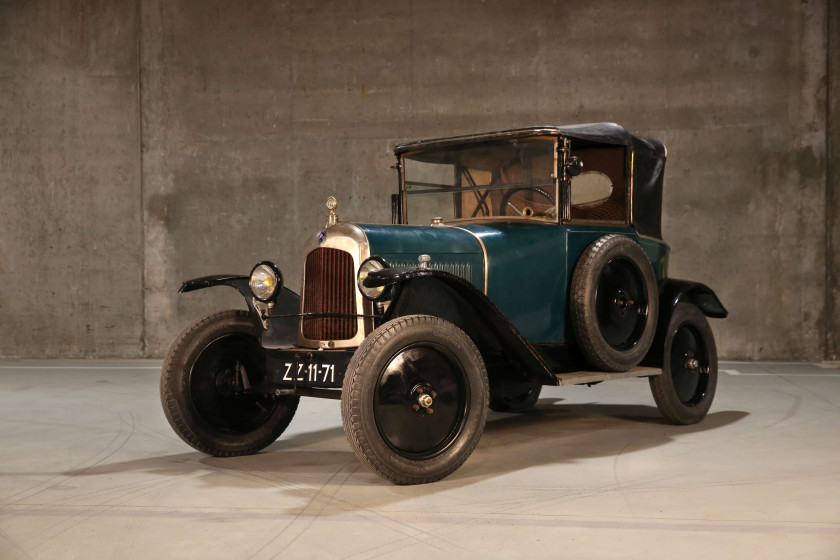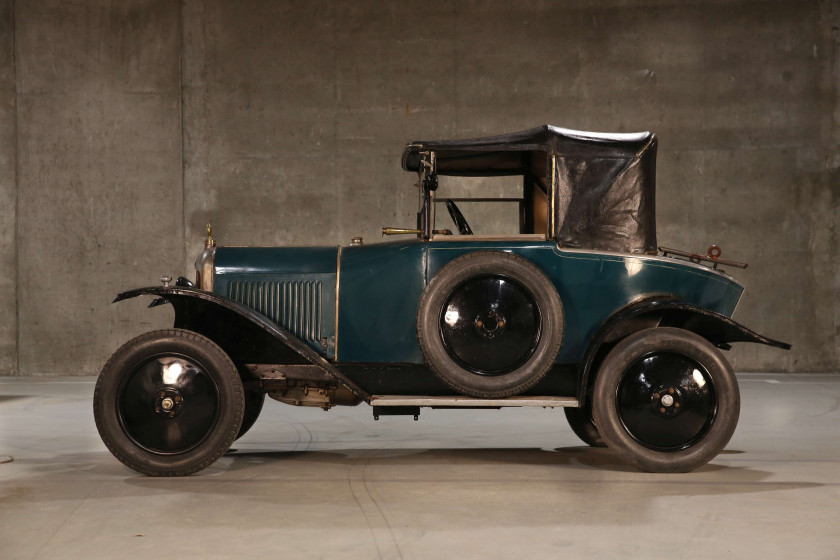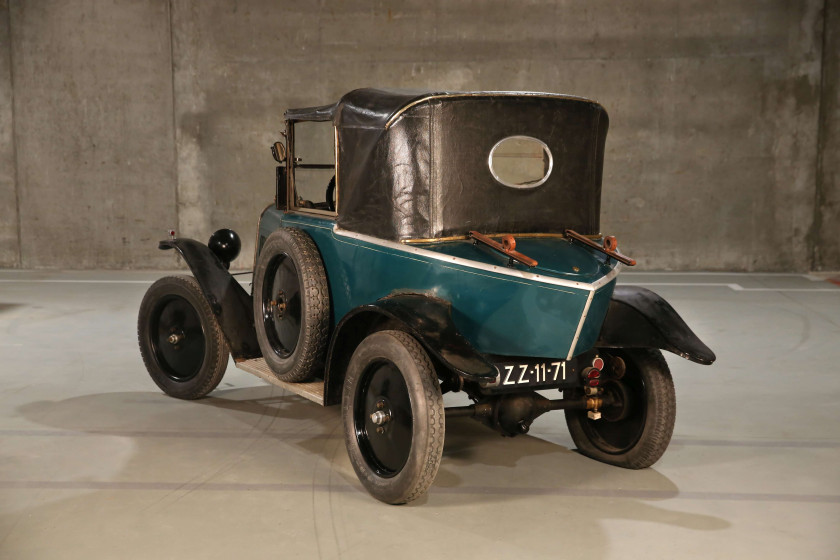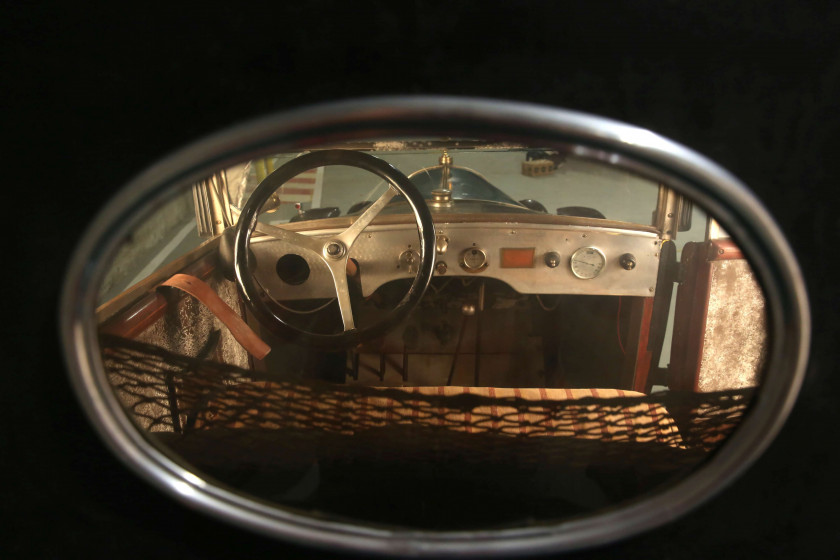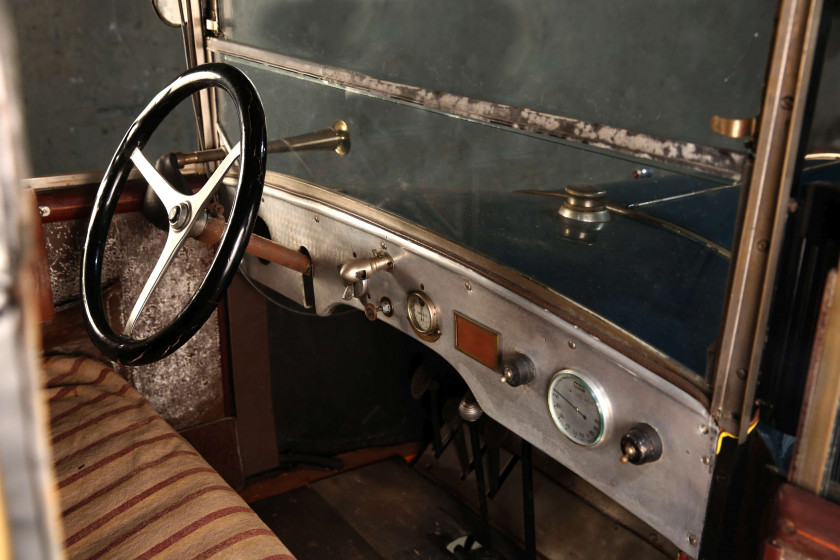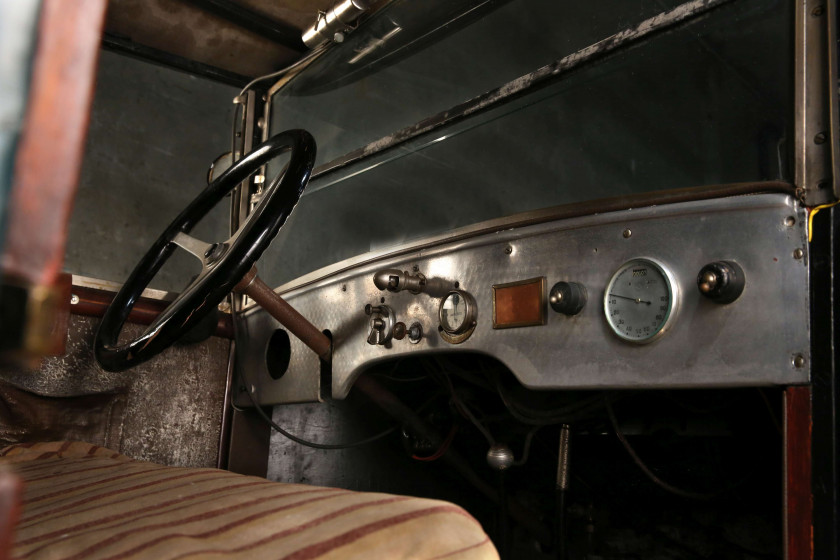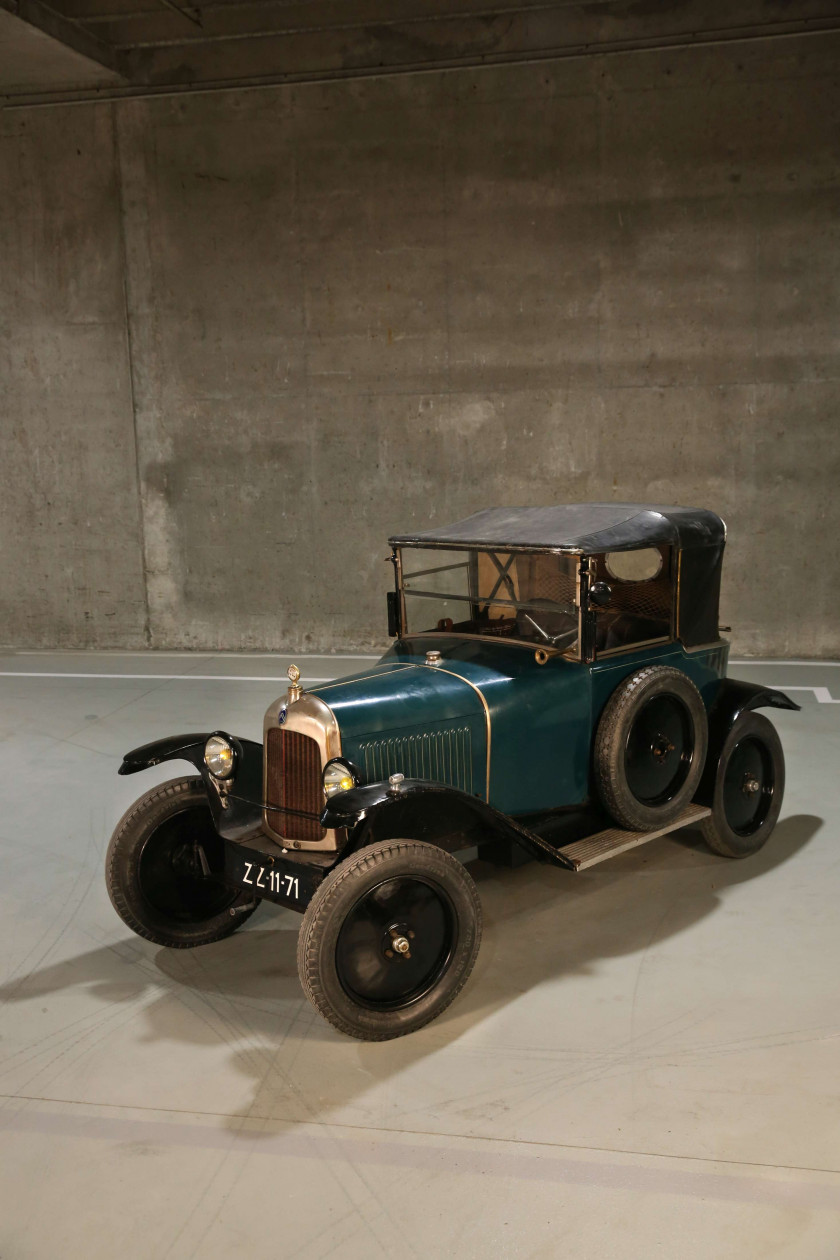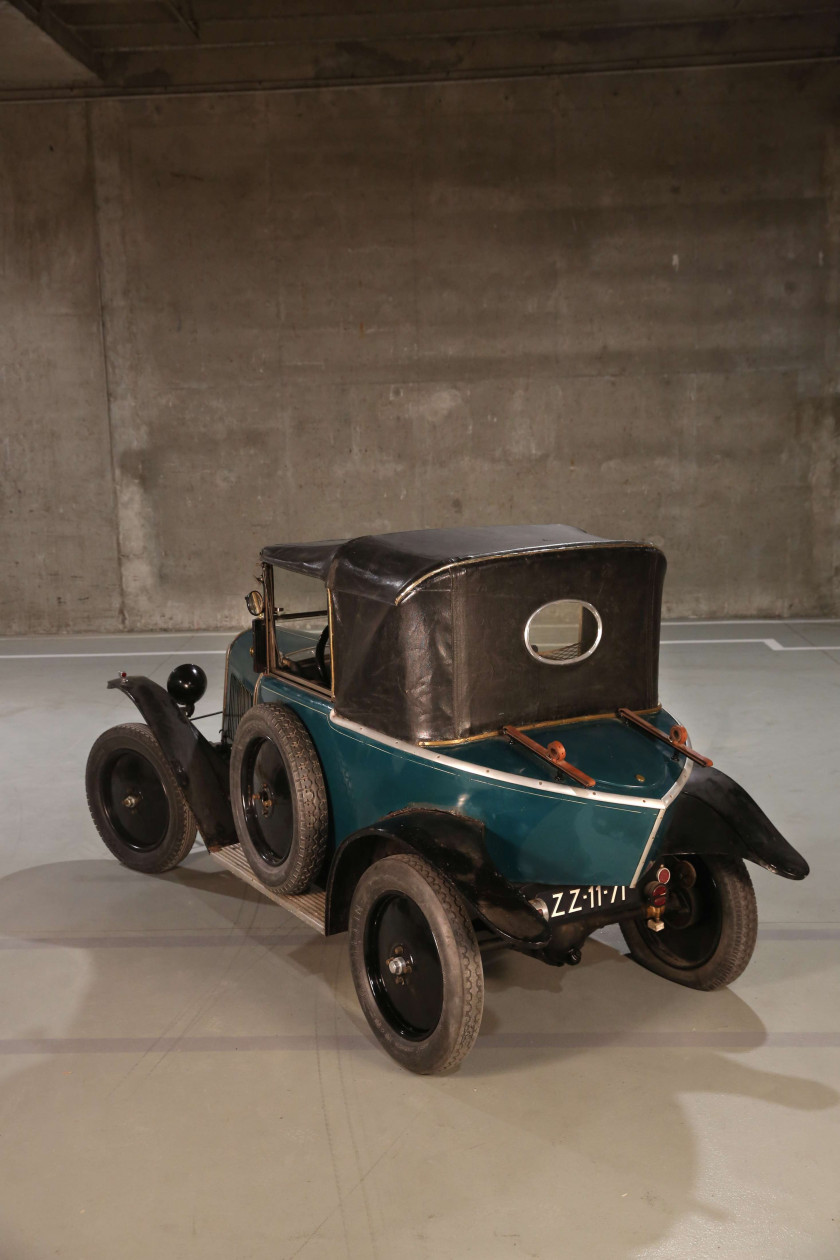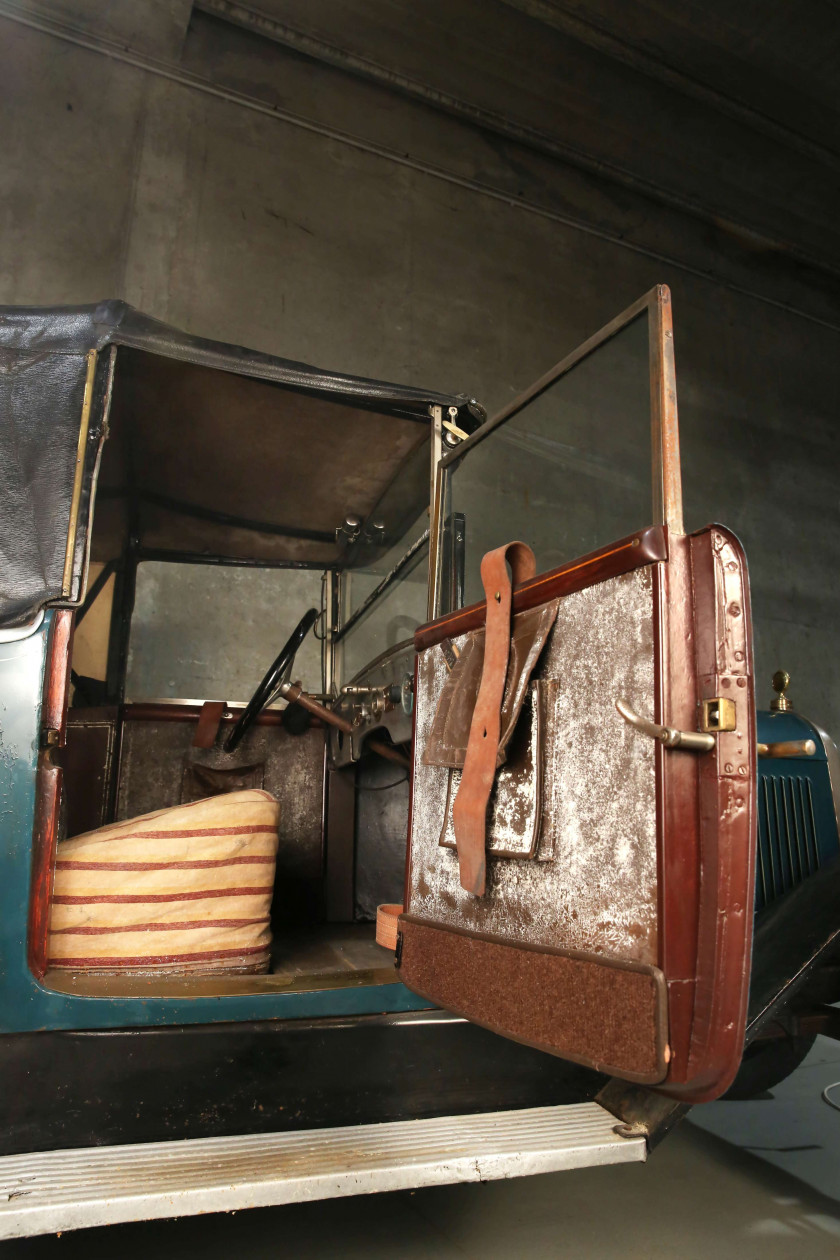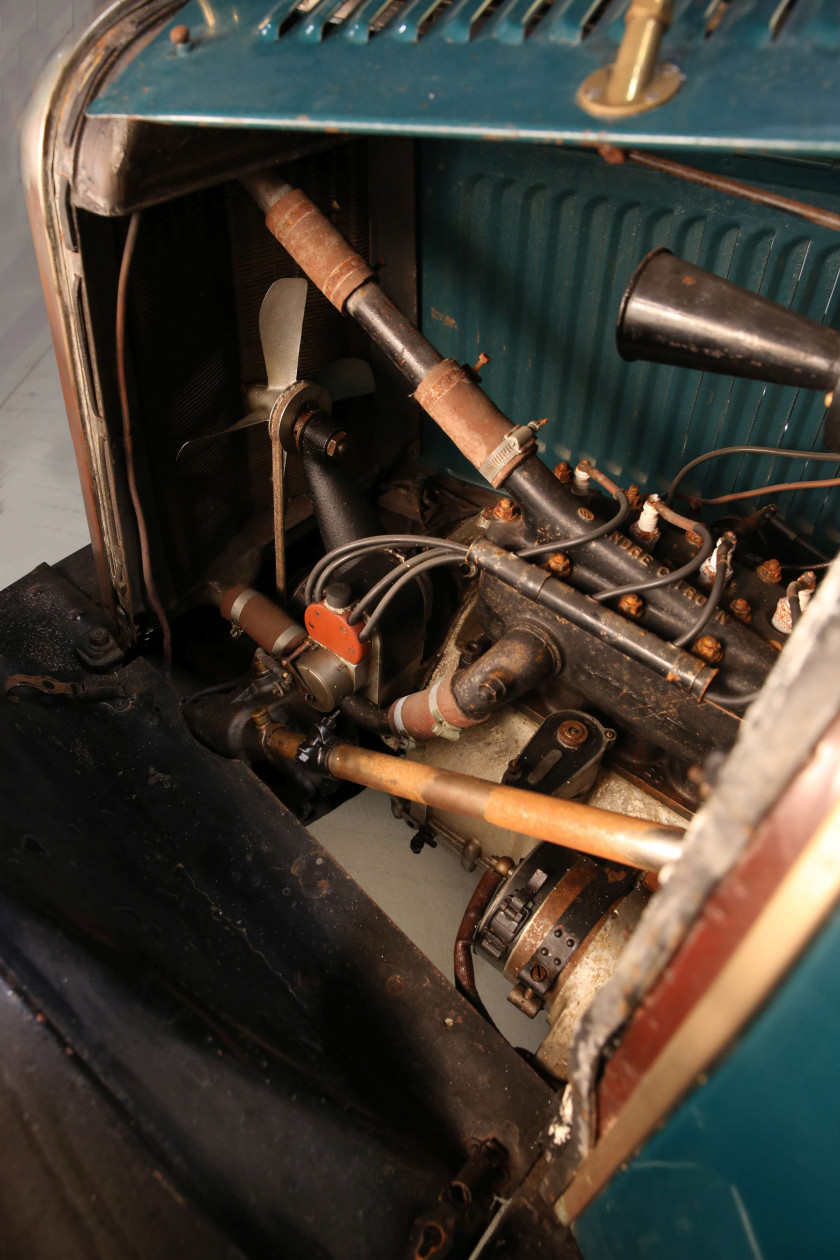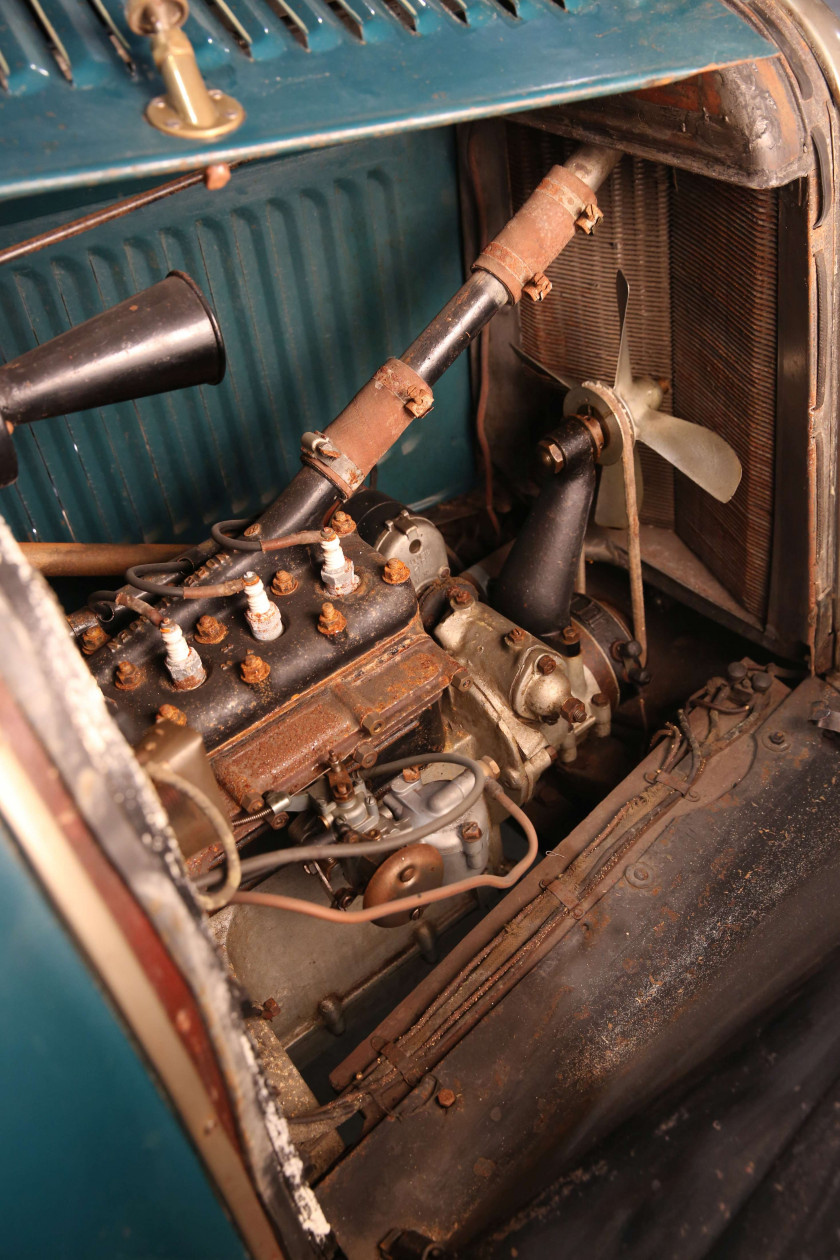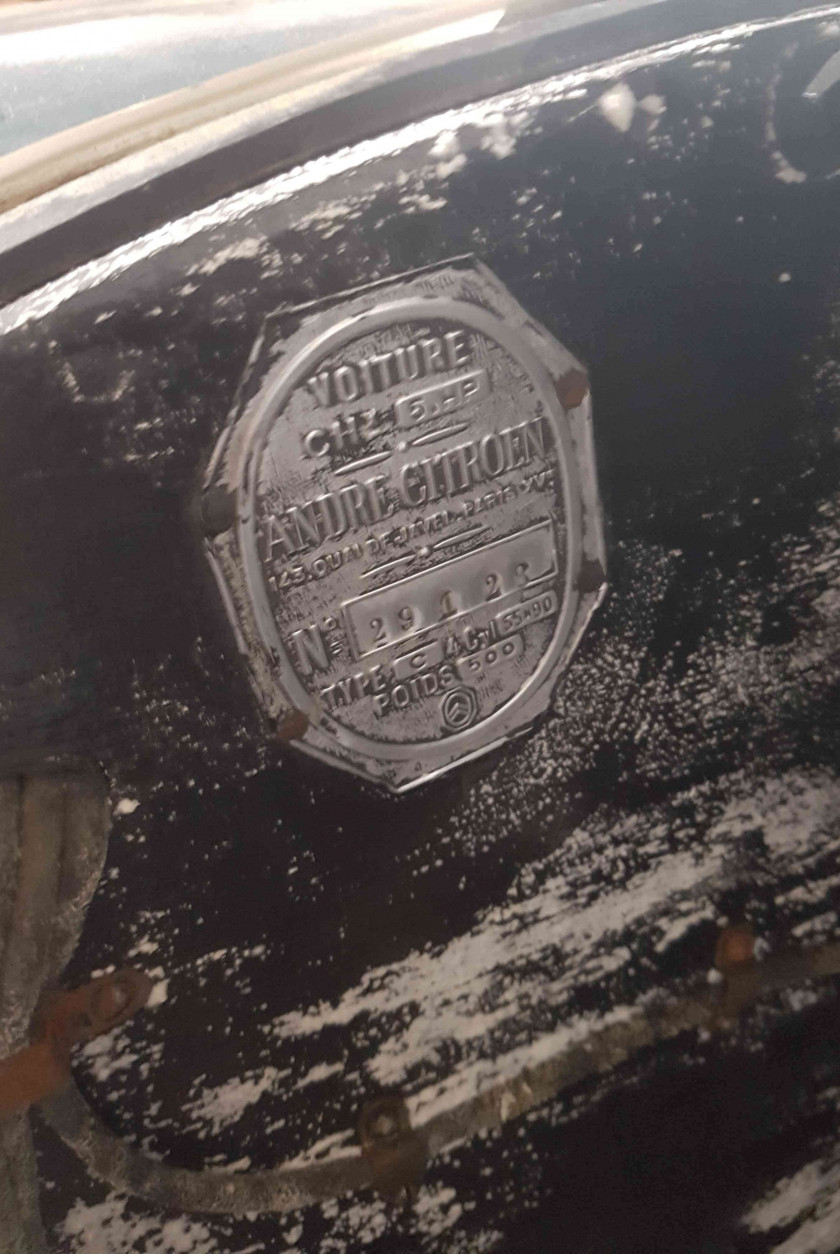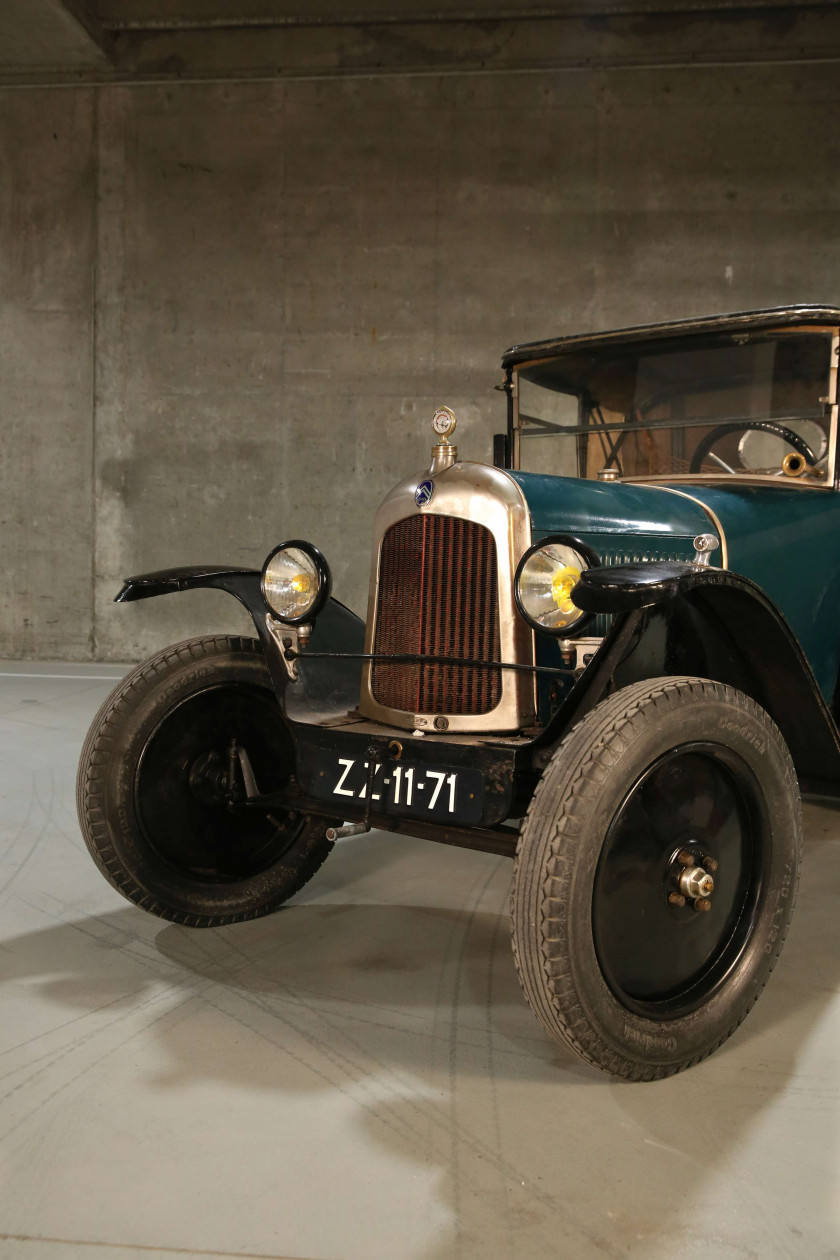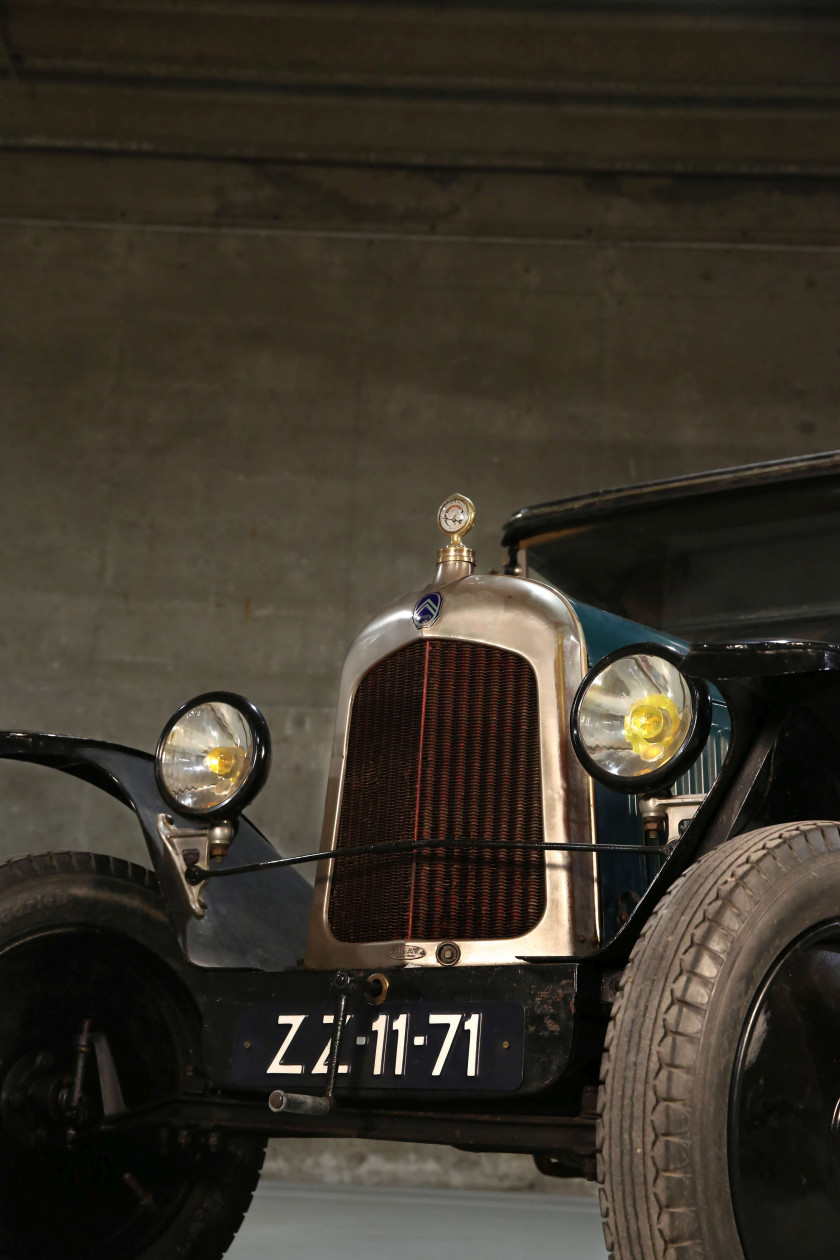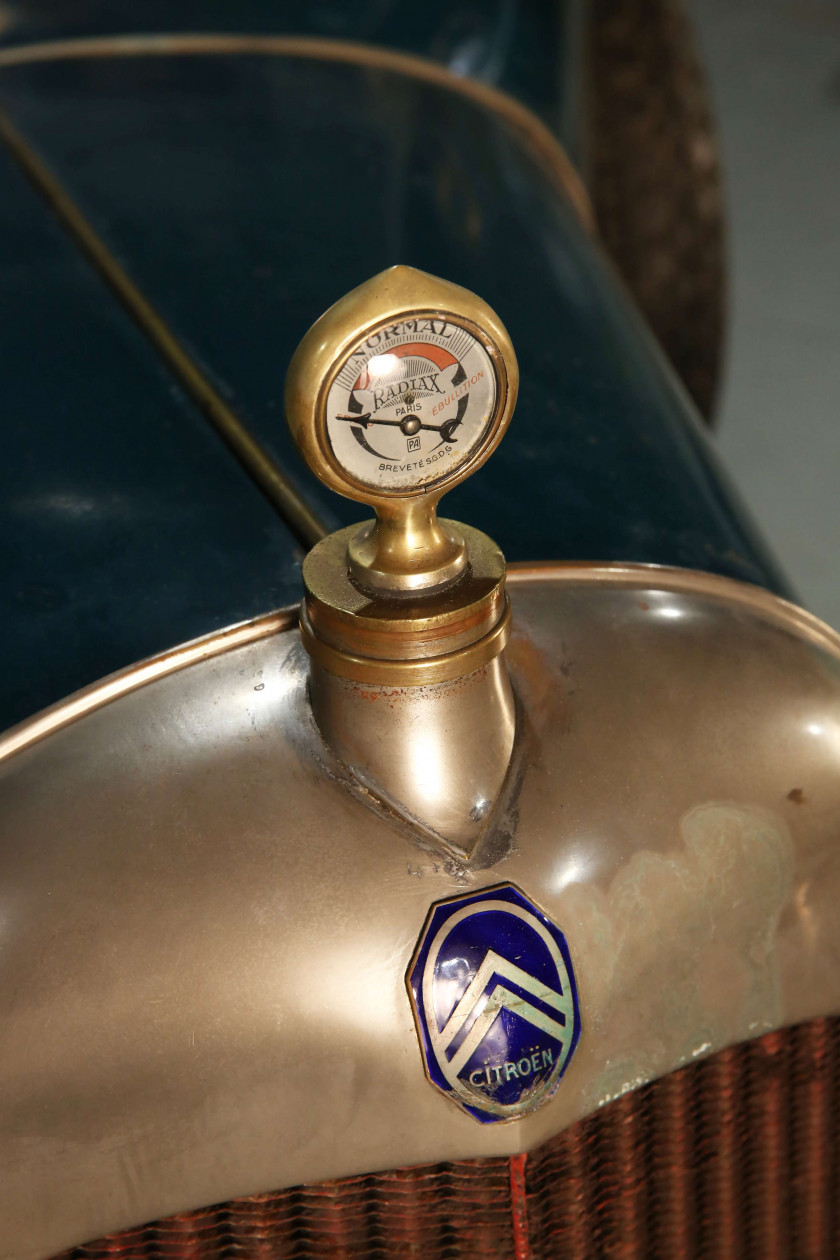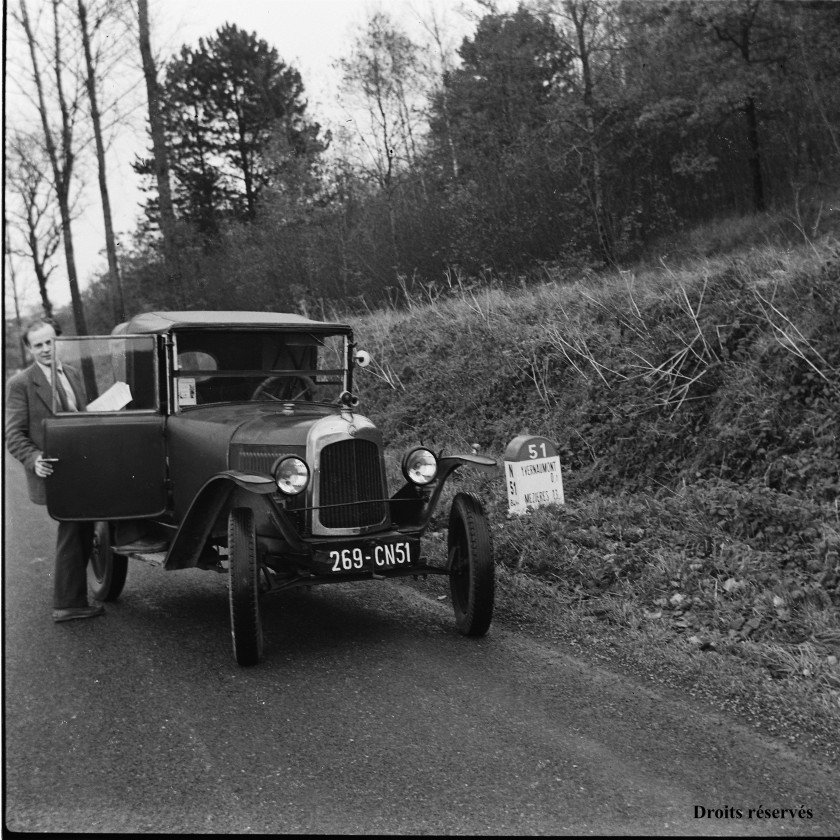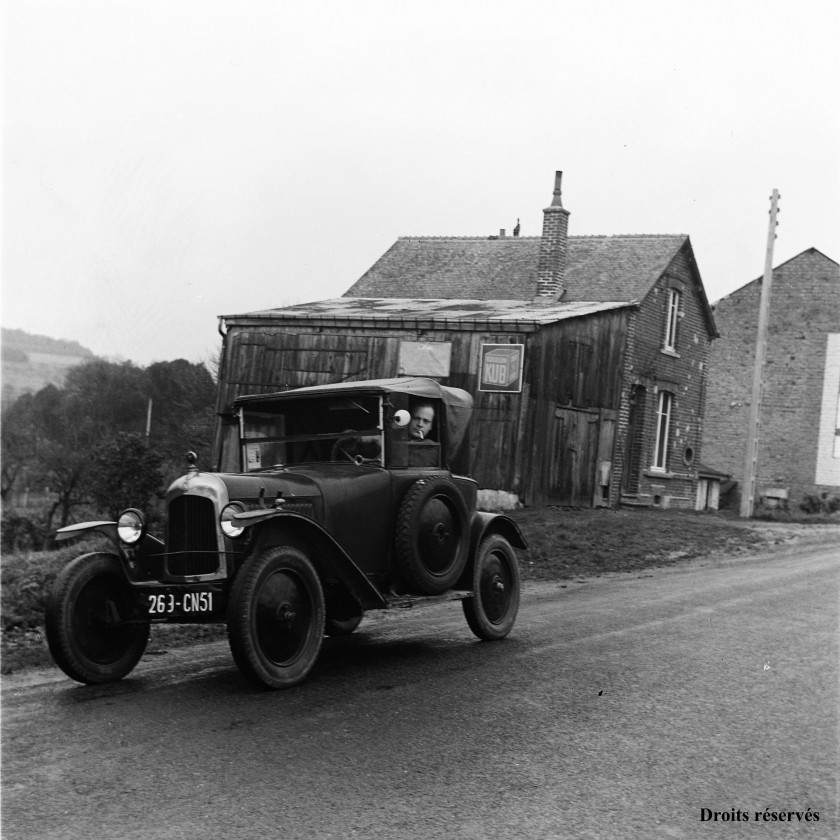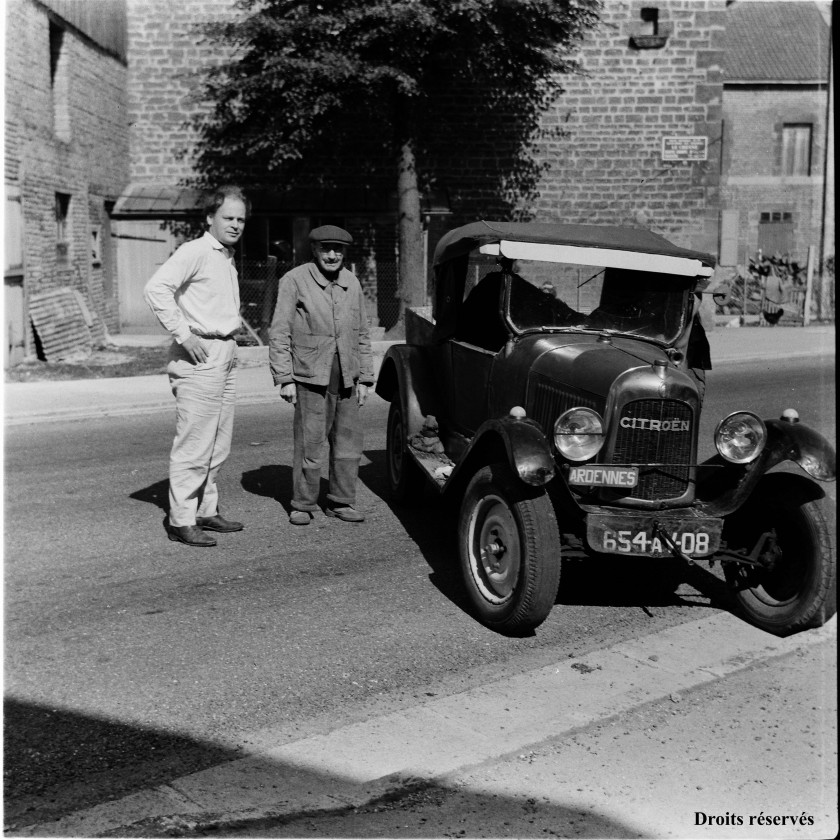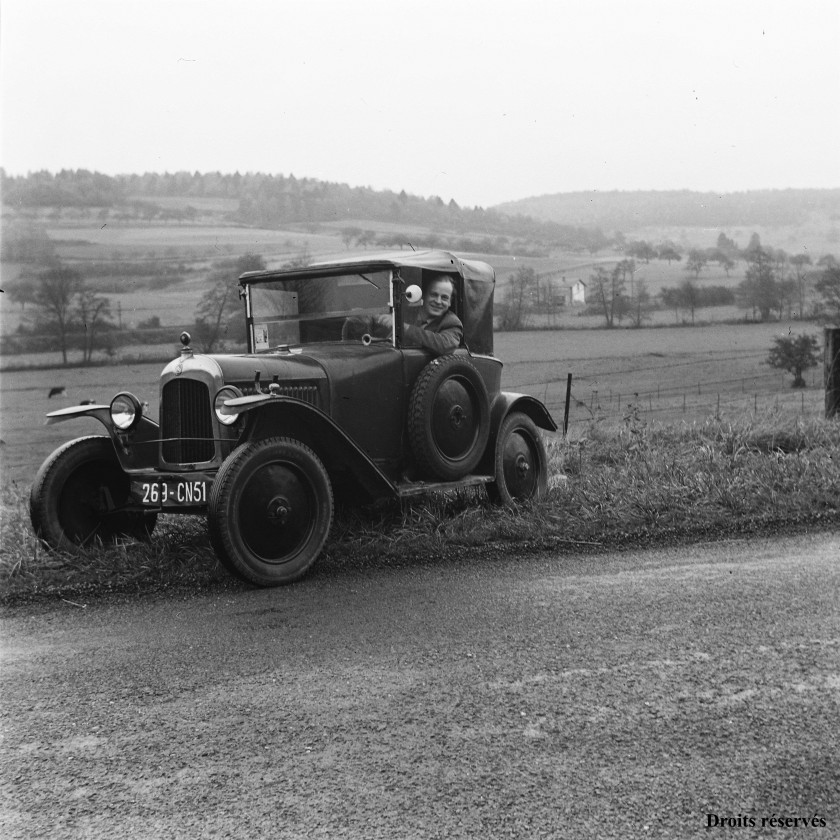Sale Rétromobile 2019 The Official Sale - 08 february 2019 /Lot 32 C.1925 Citroën 5 HP Cabriolet No reserve
C.1925 Citroën 5 HP Cabriolet
No reserve
Titre de circulation hollandais
Châssis n° 29123
- Superbe état de conservation
- Confortable version cabriolet
- Modèle apprécié
- Sans réserve
André Citroën a voulu faire de la 5 HP une "vraie" voiture, et non pas un cyclecar sommaire, capable de répondre aux besoins de ceux qui n'ont pas les moyens d'acquérir une 10 HP. Bien conçue, économique et robuste, la 5 HP va connaître rapidement une enviable popularité. D'abord proposée en torpédo deux places, la gamme va s'enrichir d'un cabriolet, puis d'un torpédo à trois places en trèfle.
L'exemplaire présenté offre la carrosserie la plus confortable, le cabriolet, puisqu'il est équipé de vitres latérales descendantes protégeant du vent et des intempéries. Il a intégré la collection Thomassen il y'a des décennies et cohabitait avec la Bugatti 49, immobile, au fond du garage. Base visiblement très saine, la voiture a bénéficié d'une remise en état ancienne qui a contribué à la conserver dans l'état exceptionnel dans lequel elle se trouve. Nous avons été émus par les nombreux petits détails qui lui confèrent tant de charme, tel que le filet à chapeaux derrière la banquette, ou encore le bouchon de radiateur accessoire Radiax avec thermomètre intégré. Complète, à l'exception de l'horloge, et conforme à sa configuration d'origine, elle mérite une remise en état mécanique pour reprendre le chemin du réseau secondaire et enchanter tant son heureux conducteur que les passants étonnés.
August Thomassen naît en 1923 dans une famille de cinq enfants à Maastricht. Il est le fils d'un pharmacien et d'une mère d'origine française qui vit pour la peinture, la littérature, la musique, la culture.
Le père Thomassen est un des premiers à circuler en automobile à Maastricht et sa fille aînée est même la première femme de Maastricht à avoir un permis de conduire ! Le samedi, le petit August a le droit d'accompagner son père dans la voiture pour la livraison des médicaments dans les villages environnants. Les vacances se font également en voiture et elle mène la famille en France. Tellement fasciné par ce phénomène automobile, à 8 ans, August fabrique sa première voiture en bois. Cette passion ne va plus le quitter.
August est un enfant original qui s'échappe toujours pour partir à l'aventure. A 9 ans, il tombe d'un pont et entre dans le coma pendant trois semaines. Après avoir survécu aussi à la paralysie infantile et à la polio, il devient l'enfant terrible de la famille à l'adolescence. Là où son frère et ses sœurs suivent leurs études universitaires, August aime être au contact des artisans, des techniciens et des mécaniciens. Bien qu'interdite par sa famille, sa fascination pour le mouvement et la vitesse l'emmène au vélo de course, discipline dans laquelle il remporte de nombreuses victoires. Ses sœurs cachaient ses trophées dans leurs chambres à coucher. Ses parents lui permettent de quitter le lycée à l'âge de 15 ans et le laisser rejoindre la fameuse école Autoschool à Den Bosch. C'est alors qu'il commence également la sculpture.
La guerre éclate. Son frère aîné est un chef de la résistance. Un soir, alors qu'il aide les gens à faire passer la frontière, il est repéré par les allemands. Après un interrogatoire douloureux, il est déporté en camp de travail en Allemagne où des bombes sont fabriquées par les prisonniers. Afin de ne pas collaborer, il se coupe délibérément un doigt. Un soir, il décide de s'enfuir dans une évasion spectaculaire où il s'accroche sous le châssis du train de marchandises qui traverse le camp. En habits de prison, le jeune August parcourt l'Allemagne hitlérienne en sautant dans les trains. Au risque de la fusillade, il atteint finalement les Pays-Bas en vie, grâce à un conducteur de train allemand silencieux et bienveillant. Après une nuit passée dans un cercueil au cimetière, il se rend chez ses oncles Brand (de la bière Brand) qui le laissent partir se cacher dans leur villa à Eijsden. Durant cette période cachée, il développa sa seconde passion: la sculpture. La résistance le mène à intervenir dans la RAF en Angleterre jusqu'à la fin de la guerre.
Après la guerre, il fabrique une moto à partir de pièces détachées et voyage en Espagne pendant 5 mois. Il étudie pendant trois mois à l'Académie des Beaux-Arts de Madrid et au Prado où il sent le destin de sa vie s'imposer : la recherche de la beauté humaine à travers la sculpture. À son retour, il est admis à l'Académie Royale des Beaux-Arts de Bruxelles, où il obtient son diplôme avec un premier prix en portrait. Sa première commande est de deux sculptures de trois mètres de haut pour les usines de biscuits ´Liga'. Avec cette première vente, il achète un terrain en Belgique et construit le studio où resteront ses futures Bugatti T49 et T57, ainsi que la Citroën Trèfle, pendant près de 60 ans.
Les commandes de ses portraits psychologiques d'hommes politiques, d'acteurs et d'industriels le conduisent à Genève, où il achète sa deuxième Bugatti T57 du chocolatier genevois Pertuiset. Sa première Bugatti T49 a alors déjà été achetée dans les Vosges, à Germigny, chez deux paysans qui s'en servaient pour transporter les pommes de terre ! En 1958, il épouse la belle Renée Van Noorden, qui l'assiste désormais dans ses passions. Ensemble, ils auront deux filles. Il joue du violon, ce qui lui permet de contrôler son caractère hypersensible et agité.
En 1963, il achète un site dans les montagnes de la Haute Savoie: la terre de ses ancêtres. Il y construit son deuxième studio, et se sentira français toute sa vie. Là, il travaillera également pendant des années pour remettre dans l'état d'origine son adorée Bugatti T40, ceci aux côtés de Schneider, l'ancien maître-artisan de Gangloff. Vers 1985, son buste d'Ettore Bugatti est acheté par le Musée National de l'Automobile à Mulhouse, où il y est encore aujourd'hui. En 1987, son buste en bronze de Yehudi Menuhin est dévoilé par le fameux violoniste dans son école éponyme à Londres. Le buste de Lips, fondateur du Musée National de l'Automobile de Hollande est inauguré en 1990.
August Thomassen travaille sur ses deux passions, les Bugatti et la sculpture, dans ses ateliers en Belgique et en Haute-Savoie jusqu'à sa maladie à l'âge de 90 ans. Personne n'est resté insensible à cette personnalité passionnée et charismatique qui a façonné sa vie de manière aussi décalée et en dehors de tous les sentiers battus.
Comme l'a écrit Yehudi Menuhin :
"Je vous admire - le grand sculpteur qui ressent profondément".
Dutch title
Chassis # 29123
- In a superb state of conservation
- A comfortable cabriolet version
- Popular model
- No reserve
André Citroën wanted to make the 5 HP a "real" car, not a simple cyclecar, but one able to meet the needs of those who could not afford a 10 HP. Well designed, economical and robust, the 5 HP quickly becomes very popular. Initially offered as a two-seater tourer, the range was extended to a cabriolet, then a three-seater tourer in the shape of a cloverleaf.
The car on offer has the most comfortable body, the cabriolet, since it is equipped with sliding side windows, protecting well from wind and weather. It joint the Thomassen collection decades ago and coexisted with the Bugatti 49 at the back of the garage. In apparently sound condition, the car has benefited from an old restoration, which has helped keeping it in exceptional condition. The many fine details gives this car a lot of charm, such as the hat net behind the bench, or the Radiax accessory radiator cap with built-in thermometer. A very complete car, with the exception of the clock, and in keeping with its original configuration, the car needs a mechanical overhaul to be able to get back on to the road, and will surely delight both driver and the astonished passersby.
August Thomassen was one of five children, born in Maastricht in 1923. His father was a pharmacist and his mother, of French origin, lived for painting, literature, music and culture.
Thomassen's father was one of the first people to drive an automobile in Maastricht and his eldest daughter the first woman to have a driver's licence in the town! On Saturdays, young August was allowed to accompany his father in the car, delivering medications to the surrounding villages. The car was also a feature of their holidays, transporting the family to France. Automobiles held a real fascination for August and he made his first model of a car in wood when he was eight. It was a passion that never left him.
August was an unusual child who was always running off in search of an adventure. At the age of nine, he fell from a bridge and was in a coma for three weeks. Having also survived infantile paralysis and polio, he became the 'enfant terrible' of the family during his teenage years. While his brother and sisters went to university, August preferred to spend time with craftsmen, technicians and mechanics. Although his family forbade it, his fascination for speed and movement led him into cycle racing, in which he won many victories. His sisters kept his trophies out of sight in their bedrooms. His parents allowed him to leave school at 15 and join the famous Autoschool in Den Bosch. This was also when he first took up sculpture.
War broke out. His older brother was a leader in the resistance. One evening, while helping people cross the border, he was spotted by the Germans. Following a painful interrogation, he was deported to a labour camp in Germany, where the prisoners had to make bombs. To avoid collaborating, he deliberately cut his finger. One evening, he decided to make his escape in daring fashion, by clinging to the underneath of the freight train that passed through the camp. Dressed in prison clothes, the young August travelled through Hitler's Germany, jumping on and off trains. Perpetually at risk of being shot, he finally reached the Netherlands alive, thanks to a sympathetic German train driver who kept quiet. Following a night spent in a coffin in a cemetery, he found his way back to his uncles Brand (of Brand beer) who agreed he could go and hide in their villa in Eijsden. During this period in hiding, he cultivated his second passion, sculpture. His involvement with the resistance led him to collaborate with the RAF in England until the end of the war.
After the war, he built a motorcycle from spare parts and travelled around Spain for five months. He spent three months studying at the Academy of Fine Arts in Madrid and the Prado, where he began to understand his destiny: to study the beauty of the human form through sculpture. On his return from Spain, was admitted to the Royal Academy of Fine Art in Brussels, where he obtained his degree and won a first prize in portraiture. His first commission was for two sculptures three metres high for the 'Liga' biscuit factory. With his earnings he bought a piece of land in Belgium and built a studio where his future Bugatti T49 and T57, and the Citroën Trèfle, would reside for nearly 60 years.
Commissions of his typical psychological portraits of politicians, actors and businessmen took him to Geneva, where he bought his second Bugatti T57 from the Geneva chocolatier Pertuiset. His first Bugatti T49 had been acquired in the Vosges, Germigny, from two farm workers who had been using the car to transport potatoes ! In 1958, he married the lovely Renée Van Noorden, who from the start encouraged him to pursue his passions. Together they would have two daughters. Every day he played the violin to manage his hypersensitive and restless character.
In 1963, August Thomassen bought a site in the mountains in Haute Savoie : the land of his ancestors. He built his second studio there, and considered himself to be French for the rest of his life. It was here that he worked for years restoring his beloved Bugatti T40 to its original condition, working alongside Schneider, the former master craftsman at Gangloff. Around 1985, his bust of Ettore Bugatti was bought by the National Automobile Museum in Mulhouse, and remains there today. In 1987, his bronze bust of Yehudi Menuhin was unveiled by the famous violinist at the Menuhin School of Music in London. The bust of Lips, the founder of the National Automobile Museum of Holland was inaugurated in 1990.
His Bugattis inspired him by their pure forms and lines; their eternal beauty was priceless to him.
August Thomassen worked on his two passions, Bugattis and sculpture, in his studios in Belgium and Haute-Savoie, until illness prevented him at the age of 90. It is impossible to remain unmoved by the passion and charisma of this character who shaped his life in such a determined and unusual way.
As Yehudi Menuhin wrote:
" I admire you - the great sculptor who feels so deeply. "
Photos © Xavier de Nombel
Estimation 10 000 - 15 000 €
Sold 21,456 €
* Results are displayed including buyer’s fees and taxes. They are generated automatically and can be modified.
No reserve
Titre de circulation hollandais
Châssis n° 29123
- Superbe état de conservation
- Confortable version cabriolet
- Modèle apprécié
- Sans réserve
André Citroën a voulu faire de la 5 HP une "vraie" voiture, et non pas un cyclecar sommaire, capable de répondre aux besoins de ceux qui n'ont pas les moyens d'acquérir une 10 HP. Bien conçue, économique et robuste, la 5 HP va connaître rapidement une enviable popularité. D'abord proposée en torpédo deux places, la gamme va s'enrichir d'un cabriolet, puis d'un torpédo à trois places en trèfle.
L'exemplaire présenté offre la carrosserie la plus confortable, le cabriolet, puisqu'il est équipé de vitres latérales descendantes protégeant du vent et des intempéries. Il a intégré la collection Thomassen il y'a des décennies et cohabitait avec la Bugatti 49, immobile, au fond du garage. Base visiblement très saine, la voiture a bénéficié d'une remise en état ancienne qui a contribué à la conserver dans l'état exceptionnel dans lequel elle se trouve. Nous avons été émus par les nombreux petits détails qui lui confèrent tant de charme, tel que le filet à chapeaux derrière la banquette, ou encore le bouchon de radiateur accessoire Radiax avec thermomètre intégré. Complète, à l'exception de l'horloge, et conforme à sa configuration d'origine, elle mérite une remise en état mécanique pour reprendre le chemin du réseau secondaire et enchanter tant son heureux conducteur que les passants étonnés.
August Thomassen naît en 1923 dans une famille de cinq enfants à Maastricht. Il est le fils d'un pharmacien et d'une mère d'origine française qui vit pour la peinture, la littérature, la musique, la culture.
Le père Thomassen est un des premiers à circuler en automobile à Maastricht et sa fille aînée est même la première femme de Maastricht à avoir un permis de conduire ! Le samedi, le petit August a le droit d'accompagner son père dans la voiture pour la livraison des médicaments dans les villages environnants. Les vacances se font également en voiture et elle mène la famille en France. Tellement fasciné par ce phénomène automobile, à 8 ans, August fabrique sa première voiture en bois. Cette passion ne va plus le quitter.
August est un enfant original qui s'échappe toujours pour partir à l'aventure. A 9 ans, il tombe d'un pont et entre dans le coma pendant trois semaines. Après avoir survécu aussi à la paralysie infantile et à la polio, il devient l'enfant terrible de la famille à l'adolescence. Là où son frère et ses sœurs suivent leurs études universitaires, August aime être au contact des artisans, des techniciens et des mécaniciens. Bien qu'interdite par sa famille, sa fascination pour le mouvement et la vitesse l'emmène au vélo de course, discipline dans laquelle il remporte de nombreuses victoires. Ses sœurs cachaient ses trophées dans leurs chambres à coucher. Ses parents lui permettent de quitter le lycée à l'âge de 15 ans et le laisser rejoindre la fameuse école Autoschool à Den Bosch. C'est alors qu'il commence également la sculpture.
La guerre éclate. Son frère aîné est un chef de la résistance. Un soir, alors qu'il aide les gens à faire passer la frontière, il est repéré par les allemands. Après un interrogatoire douloureux, il est déporté en camp de travail en Allemagne où des bombes sont fabriquées par les prisonniers. Afin de ne pas collaborer, il se coupe délibérément un doigt. Un soir, il décide de s'enfuir dans une évasion spectaculaire où il s'accroche sous le châssis du train de marchandises qui traverse le camp. En habits de prison, le jeune August parcourt l'Allemagne hitlérienne en sautant dans les trains. Au risque de la fusillade, il atteint finalement les Pays-Bas en vie, grâce à un conducteur de train allemand silencieux et bienveillant. Après une nuit passée dans un cercueil au cimetière, il se rend chez ses oncles Brand (de la bière Brand) qui le laissent partir se cacher dans leur villa à Eijsden. Durant cette période cachée, il développa sa seconde passion: la sculpture. La résistance le mène à intervenir dans la RAF en Angleterre jusqu'à la fin de la guerre.
Après la guerre, il fabrique une moto à partir de pièces détachées et voyage en Espagne pendant 5 mois. Il étudie pendant trois mois à l'Académie des Beaux-Arts de Madrid et au Prado où il sent le destin de sa vie s'imposer : la recherche de la beauté humaine à travers la sculpture. À son retour, il est admis à l'Académie Royale des Beaux-Arts de Bruxelles, où il obtient son diplôme avec un premier prix en portrait. Sa première commande est de deux sculptures de trois mètres de haut pour les usines de biscuits ´Liga'. Avec cette première vente, il achète un terrain en Belgique et construit le studio où resteront ses futures Bugatti T49 et T57, ainsi que la Citroën Trèfle, pendant près de 60 ans.
Les commandes de ses portraits psychologiques d'hommes politiques, d'acteurs et d'industriels le conduisent à Genève, où il achète sa deuxième Bugatti T57 du chocolatier genevois Pertuiset. Sa première Bugatti T49 a alors déjà été achetée dans les Vosges, à Germigny, chez deux paysans qui s'en servaient pour transporter les pommes de terre ! En 1958, il épouse la belle Renée Van Noorden, qui l'assiste désormais dans ses passions. Ensemble, ils auront deux filles. Il joue du violon, ce qui lui permet de contrôler son caractère hypersensible et agité.
En 1963, il achète un site dans les montagnes de la Haute Savoie: la terre de ses ancêtres. Il y construit son deuxième studio, et se sentira français toute sa vie. Là, il travaillera également pendant des années pour remettre dans l'état d'origine son adorée Bugatti T40, ceci aux côtés de Schneider, l'ancien maître-artisan de Gangloff. Vers 1985, son buste d'Ettore Bugatti est acheté par le Musée National de l'Automobile à Mulhouse, où il y est encore aujourd'hui. En 1987, son buste en bronze de Yehudi Menuhin est dévoilé par le fameux violoniste dans son école éponyme à Londres. Le buste de Lips, fondateur du Musée National de l'Automobile de Hollande est inauguré en 1990.
August Thomassen travaille sur ses deux passions, les Bugatti et la sculpture, dans ses ateliers en Belgique et en Haute-Savoie jusqu'à sa maladie à l'âge de 90 ans. Personne n'est resté insensible à cette personnalité passionnée et charismatique qui a façonné sa vie de manière aussi décalée et en dehors de tous les sentiers battus.
Comme l'a écrit Yehudi Menuhin :
"Je vous admire - le grand sculpteur qui ressent profondément".
Dutch title
Chassis # 29123
- In a superb state of conservation
- A comfortable cabriolet version
- Popular model
- No reserve
André Citroën wanted to make the 5 HP a "real" car, not a simple cyclecar, but one able to meet the needs of those who could not afford a 10 HP. Well designed, economical and robust, the 5 HP quickly becomes very popular. Initially offered as a two-seater tourer, the range was extended to a cabriolet, then a three-seater tourer in the shape of a cloverleaf.
The car on offer has the most comfortable body, the cabriolet, since it is equipped with sliding side windows, protecting well from wind and weather. It joint the Thomassen collection decades ago and coexisted with the Bugatti 49 at the back of the garage. In apparently sound condition, the car has benefited from an old restoration, which has helped keeping it in exceptional condition. The many fine details gives this car a lot of charm, such as the hat net behind the bench, or the Radiax accessory radiator cap with built-in thermometer. A very complete car, with the exception of the clock, and in keeping with its original configuration, the car needs a mechanical overhaul to be able to get back on to the road, and will surely delight both driver and the astonished passersby.
August Thomassen was one of five children, born in Maastricht in 1923. His father was a pharmacist and his mother, of French origin, lived for painting, literature, music and culture.
Thomassen's father was one of the first people to drive an automobile in Maastricht and his eldest daughter the first woman to have a driver's licence in the town! On Saturdays, young August was allowed to accompany his father in the car, delivering medications to the surrounding villages. The car was also a feature of their holidays, transporting the family to France. Automobiles held a real fascination for August and he made his first model of a car in wood when he was eight. It was a passion that never left him.
August was an unusual child who was always running off in search of an adventure. At the age of nine, he fell from a bridge and was in a coma for three weeks. Having also survived infantile paralysis and polio, he became the 'enfant terrible' of the family during his teenage years. While his brother and sisters went to university, August preferred to spend time with craftsmen, technicians and mechanics. Although his family forbade it, his fascination for speed and movement led him into cycle racing, in which he won many victories. His sisters kept his trophies out of sight in their bedrooms. His parents allowed him to leave school at 15 and join the famous Autoschool in Den Bosch. This was also when he first took up sculpture.
War broke out. His older brother was a leader in the resistance. One evening, while helping people cross the border, he was spotted by the Germans. Following a painful interrogation, he was deported to a labour camp in Germany, where the prisoners had to make bombs. To avoid collaborating, he deliberately cut his finger. One evening, he decided to make his escape in daring fashion, by clinging to the underneath of the freight train that passed through the camp. Dressed in prison clothes, the young August travelled through Hitler's Germany, jumping on and off trains. Perpetually at risk of being shot, he finally reached the Netherlands alive, thanks to a sympathetic German train driver who kept quiet. Following a night spent in a coffin in a cemetery, he found his way back to his uncles Brand (of Brand beer) who agreed he could go and hide in their villa in Eijsden. During this period in hiding, he cultivated his second passion, sculpture. His involvement with the resistance led him to collaborate with the RAF in England until the end of the war.
After the war, he built a motorcycle from spare parts and travelled around Spain for five months. He spent three months studying at the Academy of Fine Arts in Madrid and the Prado, where he began to understand his destiny: to study the beauty of the human form through sculpture. On his return from Spain, was admitted to the Royal Academy of Fine Art in Brussels, where he obtained his degree and won a first prize in portraiture. His first commission was for two sculptures three metres high for the 'Liga' biscuit factory. With his earnings he bought a piece of land in Belgium and built a studio where his future Bugatti T49 and T57, and the Citroën Trèfle, would reside for nearly 60 years.
Commissions of his typical psychological portraits of politicians, actors and businessmen took him to Geneva, where he bought his second Bugatti T57 from the Geneva chocolatier Pertuiset. His first Bugatti T49 had been acquired in the Vosges, Germigny, from two farm workers who had been using the car to transport potatoes ! In 1958, he married the lovely Renée Van Noorden, who from the start encouraged him to pursue his passions. Together they would have two daughters. Every day he played the violin to manage his hypersensitive and restless character.
In 1963, August Thomassen bought a site in the mountains in Haute Savoie : the land of his ancestors. He built his second studio there, and considered himself to be French for the rest of his life. It was here that he worked for years restoring his beloved Bugatti T40 to its original condition, working alongside Schneider, the former master craftsman at Gangloff. Around 1985, his bust of Ettore Bugatti was bought by the National Automobile Museum in Mulhouse, and remains there today. In 1987, his bronze bust of Yehudi Menuhin was unveiled by the famous violinist at the Menuhin School of Music in London. The bust of Lips, the founder of the National Automobile Museum of Holland was inaugurated in 1990.
His Bugattis inspired him by their pure forms and lines; their eternal beauty was priceless to him.
August Thomassen worked on his two passions, Bugattis and sculpture, in his studios in Belgium and Haute-Savoie, until illness prevented him at the age of 90. It is impossible to remain unmoved by the passion and charisma of this character who shaped his life in such a determined and unusual way.
As Yehudi Menuhin wrote:
" I admire you - the great sculptor who feels so deeply. "
Photos © Xavier de Nombel
Estimation 10 000 - 15 000 €
Sold 21,456 €
* Results are displayed including buyer’s fees and taxes. They are generated automatically and can be modified.
Lot 32
C.1925 Citroën 5 HP Cabriolet
No reserve
Lot 32
No reserve
Sold 21,456 € [$]
C.1925 Citroën 5 HP Cabriolet
No reserve
Titre de circulation hollandais
Châssis n° 29123
- Superbe état de conservation
- Confortable version cabriolet
- Modèle apprécié
- Sans réserve
André Citroën a voulu faire de la 5 HP une "vraie" voiture, et non pas un cyclecar sommaire, capable de répondre aux besoins de ceux qui n'ont pas les moyens d'acquérir une 10 HP. Bien conçue, économique et robuste, la 5 HP va connaître rapidement une enviable popularité. D'abord proposée en torpédo deux places, la gamme va s'enrichir d'un cabriolet, puis d'un torpédo à trois places en trèfle.
L'exemplaire présenté offre la carrosserie la plus confortable, le cabriolet, puisqu'il est équipé de vitres latérales descendantes protégeant du vent et des intempéries. Il a intégré la collection Thomassen il y'a des décennies et cohabitait avec la Bugatti 49, immobile, au fond du garage. Base visiblement très saine, la voiture a bénéficié d'une remise en état ancienne qui a contribué à la conserver dans l'état exceptionnel dans lequel elle se trouve. Nous avons été émus par les nombreux petits détails qui lui confèrent tant de charme, tel que le filet à chapeaux derrière la banquette, ou encore le bouchon de radiateur accessoire Radiax avec thermomètre intégré. Complète, à l'exception de l'horloge, et conforme à sa configuration d'origine, elle mérite une remise en état mécanique pour reprendre le chemin du réseau secondaire et enchanter tant son heureux conducteur que les passants étonnés.
August Thomassen naît en 1923 dans une famille de cinq enfants à Maastricht. Il est le fils d'un pharmacien et d'une mère d'origine française qui vit pour la peinture, la littérature, la musique, la culture.
Le père Thomassen est un des premiers à circuler en automobile à Maastricht et sa fille aînée est même la première femme de Maastricht à avoir un permis de conduire ! Le samedi, le petit August a le droit d'accompagner son père dans la voiture pour la livraison des médicaments dans les villages environnants. Les vacances se font également en voiture et elle mène la famille en France. Tellement fasciné par ce phénomène automobile, à 8 ans, August fabrique sa première voiture en bois. Cette passion ne va plus le quitter.
August est un enfant original qui s'échappe toujours pour partir à l'aventure. A 9 ans, il tombe d'un pont et entre dans le coma pendant trois semaines. Après avoir survécu aussi à la paralysie infantile et à la polio, il devient l'enfant terrible de la famille à l'adolescence. Là où son frère et ses sœurs suivent leurs études universitaires, August aime être au contact des artisans, des techniciens et des mécaniciens. Bien qu'interdite par sa famille, sa fascination pour le mouvement et la vitesse l'emmène au vélo de course, discipline dans laquelle il remporte de nombreuses victoires. Ses sœurs cachaient ses trophées dans leurs chambres à coucher. Ses parents lui permettent de quitter le lycée à l'âge de 15 ans et le laisser rejoindre la fameuse école Autoschool à Den Bosch. C'est alors qu'il commence également la sculpture.
La guerre éclate. Son frère aîné est un chef de la résistance. Un soir, alors qu'il aide les gens à faire passer la frontière, il est repéré par les allemands. Après un interrogatoire douloureux, il est déporté en camp de travail en Allemagne où des bombes sont fabriquées par les prisonniers. Afin de ne pas collaborer, il se coupe délibérément un doigt. Un soir, il décide de s'enfuir dans une évasion spectaculaire où il s'accroche sous le châssis du train de marchandises qui traverse le camp. En habits de prison, le jeune August parcourt l'Allemagne hitlérienne en sautant dans les trains. Au risque de la fusillade, il atteint finalement les Pays-Bas en vie, grâce à un conducteur de train allemand silencieux et bienveillant. Après une nuit passée dans un cercueil au cimetière, il se rend chez ses oncles Brand (de la bière Brand) qui le laissent partir se cacher dans leur villa à Eijsden. Durant cette période cachée, il développa sa seconde passion: la sculpture. La résistance le mène à intervenir dans la RAF en Angleterre jusqu'à la fin de la guerre.
Après la guerre, il fabrique une moto à partir de pièces détachées et voyage en Espagne pendant 5 mois. Il étudie pendant trois mois à l'Académie des Beaux-Arts de Madrid et au Prado où il sent le destin de sa vie s'imposer : la recherche de la beauté humaine à travers la sculpture. À son retour, il est admis à l'Académie Royale des Beaux-Arts de Bruxelles, où il obtient son diplôme avec un premier prix en portrait. Sa première commande est de deux sculptures de trois mètres de haut pour les usines de biscuits ´Liga'. Avec cette première vente, il achète un terrain en Belgique et construit le studio où resteront ses futures Bugatti T49 et T57, ainsi que la Citroën Trèfle, pendant près de 60 ans.
Les commandes de ses portraits psychologiques d'hommes politiques, d'acteurs et d'industriels le conduisent à Genève, où il achète sa deuxième Bugatti T57 du chocolatier genevois Pertuiset. Sa première Bugatti T49 a alors déjà été achetée dans les Vosges, à Germigny, chez deux paysans qui s'en servaient pour transporter les pommes de terre ! En 1958, il épouse la belle Renée Van Noorden, qui l'assiste désormais dans ses passions. Ensemble, ils auront deux filles. Il joue du violon, ce qui lui permet de contrôler son caractère hypersensible et agité.
En 1963, il achète un site dans les montagnes de la Haute Savoie: la terre de ses ancêtres. Il y construit son deuxième studio, et se sentira français toute sa vie. Là, il travaillera également pendant des années pour remettre dans l'état d'origine son adorée Bugatti T40, ceci aux côtés de Schneider, l'ancien maître-artisan de Gangloff. Vers 1985, son buste d'Ettore Bugatti est acheté par le Musée National de l'Automobile à Mulhouse, où il y est encore aujourd'hui. En 1987, son buste en bronze de Yehudi Menuhin est dévoilé par le fameux violoniste dans son école éponyme à Londres. Le buste de Lips, fondateur du Musée National de l'Automobile de Hollande est inauguré en 1990.
August Thomassen travaille sur ses deux passions, les Bugatti et la sculpture, dans ses ateliers en Belgique et en Haute-Savoie jusqu'à sa maladie à l'âge de 90 ans. Personne n'est resté insensible à cette personnalité passionnée et charismatique qui a façonné sa vie de manière aussi décalée et en dehors de tous les sentiers battus.
Comme l'a écrit Yehudi Menuhin :
"Je vous admire - le grand sculpteur qui ressent profondément".
Dutch title
Chassis # 29123
- In a superb state of conservation
- A comfortable cabriolet version
- Popular model
- No reserve
André Citroën wanted to make the 5 HP a "real" car, not a simple cyclecar, but one able to meet the needs of those who could not afford a 10 HP. Well designed, economical and robust, the 5 HP quickly becomes very popular. Initially offered as a two-seater tourer, the range was extended to a cabriolet, then a three-seater tourer in the shape of a cloverleaf.
The car on offer has the most comfortable body, the cabriolet, since it is equipped with sliding side windows, protecting well from wind and weather. It joint the Thomassen collection decades ago and coexisted with the Bugatti 49 at the back of the garage. In apparently sound condition, the car has benefited from an old restoration, which has helped keeping it in exceptional condition. The many fine details gives this car a lot of charm, such as the hat net behind the bench, or the Radiax accessory radiator cap with built-in thermometer. A very complete car, with the exception of the clock, and in keeping with its original configuration, the car needs a mechanical overhaul to be able to get back on to the road, and will surely delight both driver and the astonished passersby.
August Thomassen was one of five children, born in Maastricht in 1923. His father was a pharmacist and his mother, of French origin, lived for painting, literature, music and culture.
Thomassen's father was one of the first people to drive an automobile in Maastricht and his eldest daughter the first woman to have a driver's licence in the town! On Saturdays, young August was allowed to accompany his father in the car, delivering medications to the surrounding villages. The car was also a feature of their holidays, transporting the family to France. Automobiles held a real fascination for August and he made his first model of a car in wood when he was eight. It was a passion that never left him.
August was an unusual child who was always running off in search of an adventure. At the age of nine, he fell from a bridge and was in a coma for three weeks. Having also survived infantile paralysis and polio, he became the 'enfant terrible' of the family during his teenage years. While his brother and sisters went to university, August preferred to spend time with craftsmen, technicians and mechanics. Although his family forbade it, his fascination for speed and movement led him into cycle racing, in which he won many victories. His sisters kept his trophies out of sight in their bedrooms. His parents allowed him to leave school at 15 and join the famous Autoschool in Den Bosch. This was also when he first took up sculpture.
War broke out. His older brother was a leader in the resistance. One evening, while helping people cross the border, he was spotted by the Germans. Following a painful interrogation, he was deported to a labour camp in Germany, where the prisoners had to make bombs. To avoid collaborating, he deliberately cut his finger. One evening, he decided to make his escape in daring fashion, by clinging to the underneath of the freight train that passed through the camp. Dressed in prison clothes, the young August travelled through Hitler's Germany, jumping on and off trains. Perpetually at risk of being shot, he finally reached the Netherlands alive, thanks to a sympathetic German train driver who kept quiet. Following a night spent in a coffin in a cemetery, he found his way back to his uncles Brand (of Brand beer) who agreed he could go and hide in their villa in Eijsden. During this period in hiding, he cultivated his second passion, sculpture. His involvement with the resistance led him to collaborate with the RAF in England until the end of the war.
After the war, he built a motorcycle from spare parts and travelled around Spain for five months. He spent three months studying at the Academy of Fine Arts in Madrid and the Prado, where he began to understand his destiny: to study the beauty of the human form through sculpture. On his return from Spain, was admitted to the Royal Academy of Fine Art in Brussels, where he obtained his degree and won a first prize in portraiture. His first commission was for two sculptures three metres high for the 'Liga' biscuit factory. With his earnings he bought a piece of land in Belgium and built a studio where his future Bugatti T49 and T57, and the Citroën Trèfle, would reside for nearly 60 years.
Commissions of his typical psychological portraits of politicians, actors and businessmen took him to Geneva, where he bought his second Bugatti T57 from the Geneva chocolatier Pertuiset. His first Bugatti T49 had been acquired in the Vosges, Germigny, from two farm workers who had been using the car to transport potatoes ! In 1958, he married the lovely Renée Van Noorden, who from the start encouraged him to pursue his passions. Together they would have two daughters. Every day he played the violin to manage his hypersensitive and restless character.
In 1963, August Thomassen bought a site in the mountains in Haute Savoie : the land of his ancestors. He built his second studio there, and considered himself to be French for the rest of his life. It was here that he worked for years restoring his beloved Bugatti T40 to its original condition, working alongside Schneider, the former master craftsman at Gangloff. Around 1985, his bust of Ettore Bugatti was bought by the National Automobile Museum in Mulhouse, and remains there today. In 1987, his bronze bust of Yehudi Menuhin was unveiled by the famous violinist at the Menuhin School of Music in London. The bust of Lips, the founder of the National Automobile Museum of Holland was inaugurated in 1990.
His Bugattis inspired him by their pure forms and lines; their eternal beauty was priceless to him.
August Thomassen worked on his two passions, Bugattis and sculpture, in his studios in Belgium and Haute-Savoie, until illness prevented him at the age of 90. It is impossible to remain unmoved by the passion and charisma of this character who shaped his life in such a determined and unusual way.
As Yehudi Menuhin wrote:
" I admire you - the great sculptor who feels so deeply. "
Photos © Xavier de Nombel
Estimation 10 000 - 15 000 €
Sold 21,456 €
* Results are displayed including buyer’s fees and taxes. They are generated automatically and can be modified.
No reserve
Titre de circulation hollandais
Châssis n° 29123
- Superbe état de conservation
- Confortable version cabriolet
- Modèle apprécié
- Sans réserve
André Citroën a voulu faire de la 5 HP une "vraie" voiture, et non pas un cyclecar sommaire, capable de répondre aux besoins de ceux qui n'ont pas les moyens d'acquérir une 10 HP. Bien conçue, économique et robuste, la 5 HP va connaître rapidement une enviable popularité. D'abord proposée en torpédo deux places, la gamme va s'enrichir d'un cabriolet, puis d'un torpédo à trois places en trèfle.
L'exemplaire présenté offre la carrosserie la plus confortable, le cabriolet, puisqu'il est équipé de vitres latérales descendantes protégeant du vent et des intempéries. Il a intégré la collection Thomassen il y'a des décennies et cohabitait avec la Bugatti 49, immobile, au fond du garage. Base visiblement très saine, la voiture a bénéficié d'une remise en état ancienne qui a contribué à la conserver dans l'état exceptionnel dans lequel elle se trouve. Nous avons été émus par les nombreux petits détails qui lui confèrent tant de charme, tel que le filet à chapeaux derrière la banquette, ou encore le bouchon de radiateur accessoire Radiax avec thermomètre intégré. Complète, à l'exception de l'horloge, et conforme à sa configuration d'origine, elle mérite une remise en état mécanique pour reprendre le chemin du réseau secondaire et enchanter tant son heureux conducteur que les passants étonnés.
August Thomassen naît en 1923 dans une famille de cinq enfants à Maastricht. Il est le fils d'un pharmacien et d'une mère d'origine française qui vit pour la peinture, la littérature, la musique, la culture.
Le père Thomassen est un des premiers à circuler en automobile à Maastricht et sa fille aînée est même la première femme de Maastricht à avoir un permis de conduire ! Le samedi, le petit August a le droit d'accompagner son père dans la voiture pour la livraison des médicaments dans les villages environnants. Les vacances se font également en voiture et elle mène la famille en France. Tellement fasciné par ce phénomène automobile, à 8 ans, August fabrique sa première voiture en bois. Cette passion ne va plus le quitter.
August est un enfant original qui s'échappe toujours pour partir à l'aventure. A 9 ans, il tombe d'un pont et entre dans le coma pendant trois semaines. Après avoir survécu aussi à la paralysie infantile et à la polio, il devient l'enfant terrible de la famille à l'adolescence. Là où son frère et ses sœurs suivent leurs études universitaires, August aime être au contact des artisans, des techniciens et des mécaniciens. Bien qu'interdite par sa famille, sa fascination pour le mouvement et la vitesse l'emmène au vélo de course, discipline dans laquelle il remporte de nombreuses victoires. Ses sœurs cachaient ses trophées dans leurs chambres à coucher. Ses parents lui permettent de quitter le lycée à l'âge de 15 ans et le laisser rejoindre la fameuse école Autoschool à Den Bosch. C'est alors qu'il commence également la sculpture.
La guerre éclate. Son frère aîné est un chef de la résistance. Un soir, alors qu'il aide les gens à faire passer la frontière, il est repéré par les allemands. Après un interrogatoire douloureux, il est déporté en camp de travail en Allemagne où des bombes sont fabriquées par les prisonniers. Afin de ne pas collaborer, il se coupe délibérément un doigt. Un soir, il décide de s'enfuir dans une évasion spectaculaire où il s'accroche sous le châssis du train de marchandises qui traverse le camp. En habits de prison, le jeune August parcourt l'Allemagne hitlérienne en sautant dans les trains. Au risque de la fusillade, il atteint finalement les Pays-Bas en vie, grâce à un conducteur de train allemand silencieux et bienveillant. Après une nuit passée dans un cercueil au cimetière, il se rend chez ses oncles Brand (de la bière Brand) qui le laissent partir se cacher dans leur villa à Eijsden. Durant cette période cachée, il développa sa seconde passion: la sculpture. La résistance le mène à intervenir dans la RAF en Angleterre jusqu'à la fin de la guerre.
Après la guerre, il fabrique une moto à partir de pièces détachées et voyage en Espagne pendant 5 mois. Il étudie pendant trois mois à l'Académie des Beaux-Arts de Madrid et au Prado où il sent le destin de sa vie s'imposer : la recherche de la beauté humaine à travers la sculpture. À son retour, il est admis à l'Académie Royale des Beaux-Arts de Bruxelles, où il obtient son diplôme avec un premier prix en portrait. Sa première commande est de deux sculptures de trois mètres de haut pour les usines de biscuits ´Liga'. Avec cette première vente, il achète un terrain en Belgique et construit le studio où resteront ses futures Bugatti T49 et T57, ainsi que la Citroën Trèfle, pendant près de 60 ans.
Les commandes de ses portraits psychologiques d'hommes politiques, d'acteurs et d'industriels le conduisent à Genève, où il achète sa deuxième Bugatti T57 du chocolatier genevois Pertuiset. Sa première Bugatti T49 a alors déjà été achetée dans les Vosges, à Germigny, chez deux paysans qui s'en servaient pour transporter les pommes de terre ! En 1958, il épouse la belle Renée Van Noorden, qui l'assiste désormais dans ses passions. Ensemble, ils auront deux filles. Il joue du violon, ce qui lui permet de contrôler son caractère hypersensible et agité.
En 1963, il achète un site dans les montagnes de la Haute Savoie: la terre de ses ancêtres. Il y construit son deuxième studio, et se sentira français toute sa vie. Là, il travaillera également pendant des années pour remettre dans l'état d'origine son adorée Bugatti T40, ceci aux côtés de Schneider, l'ancien maître-artisan de Gangloff. Vers 1985, son buste d'Ettore Bugatti est acheté par le Musée National de l'Automobile à Mulhouse, où il y est encore aujourd'hui. En 1987, son buste en bronze de Yehudi Menuhin est dévoilé par le fameux violoniste dans son école éponyme à Londres. Le buste de Lips, fondateur du Musée National de l'Automobile de Hollande est inauguré en 1990.
August Thomassen travaille sur ses deux passions, les Bugatti et la sculpture, dans ses ateliers en Belgique et en Haute-Savoie jusqu'à sa maladie à l'âge de 90 ans. Personne n'est resté insensible à cette personnalité passionnée et charismatique qui a façonné sa vie de manière aussi décalée et en dehors de tous les sentiers battus.
Comme l'a écrit Yehudi Menuhin :
"Je vous admire - le grand sculpteur qui ressent profondément".
Dutch title
Chassis # 29123
- In a superb state of conservation
- A comfortable cabriolet version
- Popular model
- No reserve
André Citroën wanted to make the 5 HP a "real" car, not a simple cyclecar, but one able to meet the needs of those who could not afford a 10 HP. Well designed, economical and robust, the 5 HP quickly becomes very popular. Initially offered as a two-seater tourer, the range was extended to a cabriolet, then a three-seater tourer in the shape of a cloverleaf.
The car on offer has the most comfortable body, the cabriolet, since it is equipped with sliding side windows, protecting well from wind and weather. It joint the Thomassen collection decades ago and coexisted with the Bugatti 49 at the back of the garage. In apparently sound condition, the car has benefited from an old restoration, which has helped keeping it in exceptional condition. The many fine details gives this car a lot of charm, such as the hat net behind the bench, or the Radiax accessory radiator cap with built-in thermometer. A very complete car, with the exception of the clock, and in keeping with its original configuration, the car needs a mechanical overhaul to be able to get back on to the road, and will surely delight both driver and the astonished passersby.
August Thomassen was one of five children, born in Maastricht in 1923. His father was a pharmacist and his mother, of French origin, lived for painting, literature, music and culture.
Thomassen's father was one of the first people to drive an automobile in Maastricht and his eldest daughter the first woman to have a driver's licence in the town! On Saturdays, young August was allowed to accompany his father in the car, delivering medications to the surrounding villages. The car was also a feature of their holidays, transporting the family to France. Automobiles held a real fascination for August and he made his first model of a car in wood when he was eight. It was a passion that never left him.
August was an unusual child who was always running off in search of an adventure. At the age of nine, he fell from a bridge and was in a coma for three weeks. Having also survived infantile paralysis and polio, he became the 'enfant terrible' of the family during his teenage years. While his brother and sisters went to university, August preferred to spend time with craftsmen, technicians and mechanics. Although his family forbade it, his fascination for speed and movement led him into cycle racing, in which he won many victories. His sisters kept his trophies out of sight in their bedrooms. His parents allowed him to leave school at 15 and join the famous Autoschool in Den Bosch. This was also when he first took up sculpture.
War broke out. His older brother was a leader in the resistance. One evening, while helping people cross the border, he was spotted by the Germans. Following a painful interrogation, he was deported to a labour camp in Germany, where the prisoners had to make bombs. To avoid collaborating, he deliberately cut his finger. One evening, he decided to make his escape in daring fashion, by clinging to the underneath of the freight train that passed through the camp. Dressed in prison clothes, the young August travelled through Hitler's Germany, jumping on and off trains. Perpetually at risk of being shot, he finally reached the Netherlands alive, thanks to a sympathetic German train driver who kept quiet. Following a night spent in a coffin in a cemetery, he found his way back to his uncles Brand (of Brand beer) who agreed he could go and hide in their villa in Eijsden. During this period in hiding, he cultivated his second passion, sculpture. His involvement with the resistance led him to collaborate with the RAF in England until the end of the war.
After the war, he built a motorcycle from spare parts and travelled around Spain for five months. He spent three months studying at the Academy of Fine Arts in Madrid and the Prado, where he began to understand his destiny: to study the beauty of the human form through sculpture. On his return from Spain, was admitted to the Royal Academy of Fine Art in Brussels, where he obtained his degree and won a first prize in portraiture. His first commission was for two sculptures three metres high for the 'Liga' biscuit factory. With his earnings he bought a piece of land in Belgium and built a studio where his future Bugatti T49 and T57, and the Citroën Trèfle, would reside for nearly 60 years.
Commissions of his typical psychological portraits of politicians, actors and businessmen took him to Geneva, where he bought his second Bugatti T57 from the Geneva chocolatier Pertuiset. His first Bugatti T49 had been acquired in the Vosges, Germigny, from two farm workers who had been using the car to transport potatoes ! In 1958, he married the lovely Renée Van Noorden, who from the start encouraged him to pursue his passions. Together they would have two daughters. Every day he played the violin to manage his hypersensitive and restless character.
In 1963, August Thomassen bought a site in the mountains in Haute Savoie : the land of his ancestors. He built his second studio there, and considered himself to be French for the rest of his life. It was here that he worked for years restoring his beloved Bugatti T40 to its original condition, working alongside Schneider, the former master craftsman at Gangloff. Around 1985, his bust of Ettore Bugatti was bought by the National Automobile Museum in Mulhouse, and remains there today. In 1987, his bronze bust of Yehudi Menuhin was unveiled by the famous violinist at the Menuhin School of Music in London. The bust of Lips, the founder of the National Automobile Museum of Holland was inaugurated in 1990.
His Bugattis inspired him by their pure forms and lines; their eternal beauty was priceless to him.
August Thomassen worked on his two passions, Bugattis and sculpture, in his studios in Belgium and Haute-Savoie, until illness prevented him at the age of 90. It is impossible to remain unmoved by the passion and charisma of this character who shaped his life in such a determined and unusual way.
As Yehudi Menuhin wrote:
" I admire you - the great sculptor who feels so deeply. "
Photos © Xavier de Nombel
Estimation 10 000 - 15 000 €
Sold 21,456 €
* Results are displayed including buyer’s fees and taxes. They are generated automatically and can be modified.
Sale’s details
Sale: 3888
Location: Salon Rétromobile Hall 2.1 Paris Expo – Porte de Versailles 75015 Paris
Date: 08 Feb. 2019 14:00
Auctioneer: Hervé Poulain
Location: Salon Rétromobile Hall 2.1 Paris Expo – Porte de Versailles 75015 Paris
Date: 08 Feb. 2019 14:00
Auctioneer: Hervé Poulain
Contact
Absentee Bids
& Telephone Bids
Kristina Vrzests
Phone +33 1 42 99 20 51
bids@artcurial.com
Conditions of Purchase
